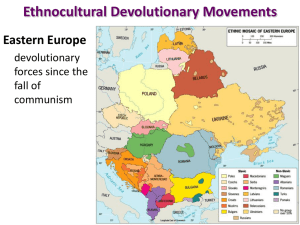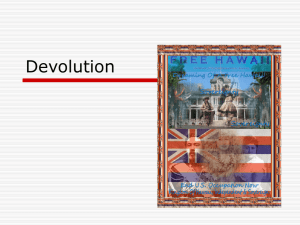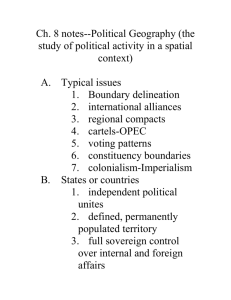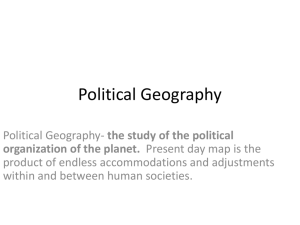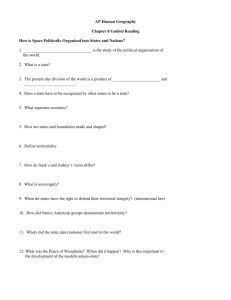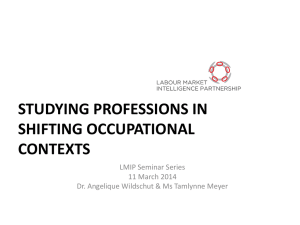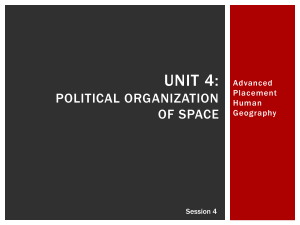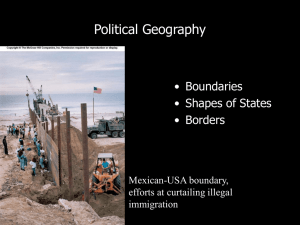Rubenstein Chapter 8 PPT Part 2
advertisement
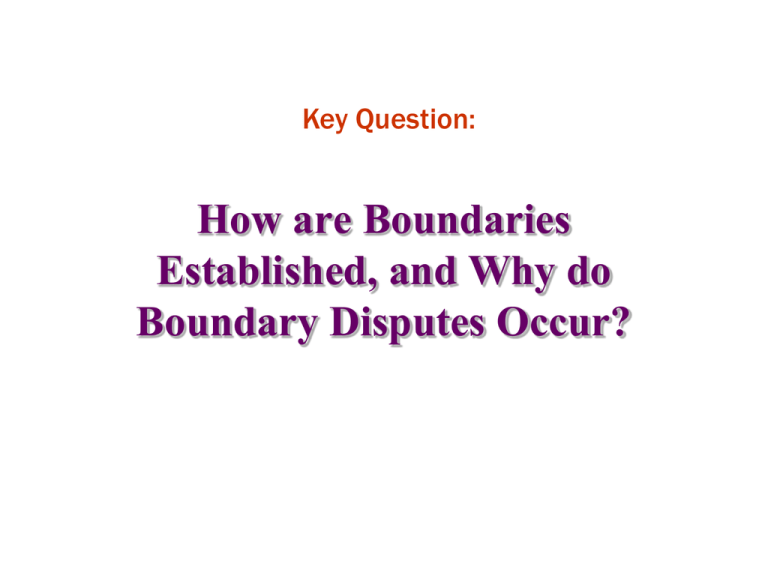
Key Question: How are Boundaries Established, and Why do Boundary Disputes Occur? Land Boundaries • Not just a line, but also a vertical plane that cuts through subsoil, rocks and the airspace abovecoal, gas & oil reserves often cross these lines. • Belgium, Germany & Netherlands argued over coal seams & natural gas reserves. • Kuwait Oil drilling prompted the 1991 Gulf War (Rumaylah Reserve) Land Boundaries • 3 Stage Evolution of Boundaries: • definition-a document is created that indicates exact landmarks; • delimitationcartographers place the boundary on the map; • demarcation-boundary markers such as steel posts or concrete pillars, fences or wall marks the boundary Land Boundaries • Frontier-a zone of separation that keeps rivals apart can be natural or manmade-such as Korean DMZ. • Boundaries keep out adversaries or keep citizens inside-limit smuggling, migration, etc. • Internal boundariesprovinces or states within a larger state. Types of Boundaries • Geometric-straight line boundary such as USCanada or many in Africa. • Physical or NaturalPolitical Boundary-river, crest of a mountain range or some other physical landmark • Cultural or AnthroGeographic Boundarybreaks in the human landscape, such as most of Europe’s boundaries Aozou Strip: A Geometric Boundary Fig. 8-9: The straight boundary between Libya and Chad was drawn by European powers, and the strip is the subject of controversy between the two countries. Left-the Demilitarized Zone between North Korea & South Korea is heavily defended by both sides Bottom left-the US-Canadian border is the longest undefended border in the world. Bottom right-the Rio Grande forms the border between Mexico and the United States which is porous enough to allow million of illegal immigrants. Genetic Boundary Classification • Richard Hartshorne, a leading political geographer developed this classification system; • Antecedent Boundary-physical landscape defined the boundary well before human habitation-MalaysiaIndonesian boundary on Borneo is sparsely settled. • Subsequent Boundary-Vietnam-China border results from a long period of modification. • Superimposed-forcibly drawn boundary that cuts across a unified cultural boundary-New Guinea-Indonesia West Irian & Papua New Guinea in the East. • Relict boundary no longer serves its purpose, but the imprint is still evident in the landscape-Vietnam-North South boundary, West and East Germany boundary, especially in Berlin. Ethnic Groups in Southwest Asia Fig. 8-14: Ethnic boundaries do not match country boundaries, especially in Iraq, Iran, Afghanistan, and Pakistan. Division of Cyprus Fig. 8-10: Cyprus has been divided into Green and Turkish portions since 1974. The Fertile Crescent Fig. 8-3: The Fertile Crescent was the site of early city-states and a succession of ancient empires. Frontiers in the Arabian Peninsula Fig. 8-8: Several states in the Arabian Peninsula are separated by frontiers rather than precise boundaries. Centripetal and Centrifugal Forces • Richard Hartshorne, a leading political geographer described Centripetal forces as things that bind or hold a nation together & promote national unity: – Strong leadership-charismatic leader – External threat – Education – Ideology-Fascism, Communism or Democracy – Movement or circulation Castro’s Cuba • The Cuban economy has been hampered by the American trade embargo and the collapse of the Soviet Union, which ended economic assistance. Centripetal and Centrifugal Forces • Centrifugal forces are things that that divide or tear a state apart: (also called Devolutionary forces) – – – – – – Ethnic or cultural differences Religious differences Linguistic diversity Economic disparity Movement or circulation Physical geographical differences Devolution – Movement of power from the central government to regional governments within the state. What causes devolutionary movements? Ethnocultural forces Economic forces Spatial forces The Forces of Devolution • After USSR collapse in 1991, optimism-a New World Order? • Supranationalism, no more costly arms race & negotiation replacing confrontation?? • Yet despite optimismpowerful self-interests contribute to centrifugal (divisive) forces. • Geopolitics-the study of political science within a geographic framework The Forces of Devolution • Since 1990 about 26 new states created. • Ironically with EU & adoption of euro greater centrifugal forces in Europe. • London’s decision to join EU encouraged Scottish nationalism. • 1990s Scottish National Party encouraged devolution. • 1997 Labour Party gave Scots & Welsh chance to vote-both voted to have their own parliaments Ethnocultural Devolutionary Movements Scotland rise in independence movement is coupled with: - European Union - Scotland’s oil resources The Forces of Devolution-Cultural Forces • Most of the world’s 200 states have multicultural populations. • Spain-Basque & Catalonia in 1979 signed autonomy agreements – – – – Have their own parliaments Languages have official status Control over education Power of taxation • But Basque separatist were not satisfied-continued bombing & terror attacks The Forces of Devolution-Cultural Forces • Quebec and Parti Quebecois in Canada • Belgium-Flemish (Dutch) in north, Walloons (French) in south • Czechoslovakia split in Jan. 1993 in the “Velvet Divorce” • Sudan-Muslim north & Christian south • Sri Lanka-Tamils, a Hindu minority fight for independence from the Sinhalese a Buddhist majority The Forces of Devolution-Cultural Forces • Greatest tragedy was Yugoslavia which erupted in Civil War in the 1990s • Thrown together after WW I with Serbia as the core of “The Land of the South Slavs” • 7 major, 17 minor ethnic groups, 3 religions & 2 alphabets • North-Croats & Slovenes-Catholic • South-Serbs are Orthodox, Muslim enclaves • Rule by royal house of Serbia, during WWII German occupation the Croats supported the Nazis, Serbs fought as anti-Nazi partisans. • Josip Broz Tito emerged as a communist leader after WWII-nationalism suppressed under his iron fist. The Forces of Devolution-Cultural Forces • After the death of Tito & later the collapse of communismethnic conflict of Croat versus Serb and everyone versus Muslims emerged again. • Slovenia, Croatia, Bosnia, Serbia-Montenegro & Macedonia became independent. • Bosnia-no clear majority, Dayton Accords partitioned Bosnia & ended the civil warMuslims 44%, Serbs 32% & Croatians 17% • Robert Mugabe’s dictatorship forced thousands of white farmers to flee Zimbabwe. Zimbabwe Genocide • Genos, greek for tribe or family, -cide from Latin to kill. • Last 100 years over 50 million people were murdered due to race, ethnicity, religion or political persuasion. – Mao Zedong-30 m. Chinese – Stalin-20 m. Soviets – Nazis-11.4 m. Jews, Slavs, etc. – Japan 10 m. Chinese, etc. Ethnocultural Devolutionary Movements Eastern Europe devolutionary forces since the fall of communism The Forces of Devolution-Economic Forces • Catalonians in Spain site reasons for economic independence-6% of territory, yet have 25% of exports & 40% of industrial exports. • Italy-Mezzorgiono (region of the south is poor & agrarian) Sardinia feels neglected and there is a growing disparity between the industrial North & agricultural South • Italy has moved to a federal system due to pressure by the north. Economic Devolutionary Movements Catalonia, Spain Barcelona is the center of banking and commerce in Spain and the region is much wealthier than the rest of Spain. The Forces of Devolution-Economic Forces • France-Corsica, a small minority of the islands 25,000 demand autonomy. It was taken from Genoese, Italy in 1768. Bomb attacks (600) in 1996 caused tourism to drop. • Brazil-1990s the 3 southern states: Rio Grande do Sul, Santa Catarina, Parana claimed the govt. misspent money in Amazon-had a leader, created flag, and demanded independence for the Republic of the Pampas. The Forces of Devolution-Spatial Forces • Spatial factors-remote frontiers, isolated villages, rugged topography or repeated historic invasions contribute to devolution • Many islands such as Corsica, Sardinia, Taiwan, Singapore, Zanzibar, Jolo (Philippines) and Puerto Rico have demanded independence. • Hawaii-indigenous population demand autonomy; Puerto Rico small, but vocal independence movement; Cascadia-Washington, Oregon & British Columbia. Spatial Devolutionary Movements Honolulu, Hawai’i A history apart from the United States, and a desire to live apart in order to keep traditions alive. Devolution of the Soviet Union • 50 years a Bi-Polar World of Cold War arms race & danger of nuclear war. • In 1980s centrifugal forces increased-multiculturalism, multinationalism, economic troubles • Gorbachev loosened the Soviet grip on Eastern Europe & at home introduced perestroika (restructuring) & glasnost (openness) • Fall of 1989 the Iron Curtain collapsed, the Berlin Wall was opened. The Devolution of the Soviet Union • Failed coup attempt in August 1991 led to the collapse of communism & dissolution of the USSR on Dec. 25, 1991. • Commonwealth of Independent States created, Baltic States & Georgia stayed out & became completely independent. • Muslim Azerbaijan & Christian Armenia had armed conflict. • Georgia had a civil war, Abkhazia in Northwest declared independence • Near Abroad-what the Russians called the 25 million Russians who live in the former Soviet Republics. The Devolution of Russia • Within Russia-16 autonomous homelands for some of the minorities-boundaries were changed to reward or punish certain groups • Soviets created many geographical problems just like the colonial powers in Asia & Africa • 1991-95 about 5 additional republics recognized in Russia • Checho-Ingushetia became Chechnya and Ingushetia • Chechnya-Muslim population in the Caucasus demanded independence-Moscow refused, war & destruction of Grozny resulted-terrorist attacks in Moscow, Beslan, etc. • Russia had given in on many occasions-created 21 republics & 68 regions in a federal framework. • Russia is still the largest nation on earth, but only 6th in population

